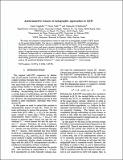Por favor, use este identificador para citar o enlazar a este item:
http://hdl.handle.net/10261/32082COMPARTIR / EXPORTAR:
 SHARE SHARE
 CORE
BASE CORE
BASE
|
|
| Visualizar otros formatos: MARC | Dublin Core | RDF | ORE | MODS | METS | DIDL | DATACITE | |

| Campo DC | Valor | Lengua/Idioma |
|---|---|---|
| dc.contributor.author | Cappiello, Luigi | - |
| dc.contributor.author | Catà, Óscar | - |
| dc.contributor.author | D'Ambrosio, Giancarlo | - |
| dc.date.accessioned | 2011-02-07T12:56:58Z | - |
| dc.date.available | 2011-02-07T12:56:58Z | - |
| dc.date.issued | 2010-11-18 | - |
| dc.identifier.citation | Physical Review - Section D - Particles and Fields 82 (9): 095008 (2010) | es_ES |
| dc.identifier.issn | 1550-7998 | - |
| dc.identifier.uri | http://hdl.handle.net/10261/32082 | - |
| dc.description.abstract | We study real (massive) antisymmetric tensors of rank two in holographic models of QCD based on the gauge/string duality. Our aim is to understand in detail how the anti-de Sitter/conformal field theory correspondence describes correlators with tensor currents in QCD. To this end we study a set of bootstrapped correlators with spin-1 vector and tensor currents, imposing matching to QCD at the partonic level. We show that a consistent description of this set of correlators yields a very predictive picture. For instance, it imposes strong constraints on infrared boundary conditions and precludes the introduction of dilatonic backgrounds as a mechanism to achieve linear confinement. Additionally, correlators with tensor currents turn out to be especially sensitive to chiral symmetry breaking, thus offering an ideal testing ground for genuine QCD effects. Several phenomenological consequences are explored, such as the nontrivial interplay between 1(+-) states and conventional 1(--) vector mesons. | es_ES |
| dc.description.sponsorship | O. C. wants to thank the University of Naples for very pleasant stays during the different stages of this work. L. C. and G. D’A. are supported in part by the EU under Contract MTRN-CT-2006-035482 (FLAVIAnet) and by MUIR, Italy, under Project 2005-023102. O. C. is supported by the EU under Contract MTRN-CT-2006-035482 (FLAVIAnet) and by MICINN, Spain, under Grants FPA2007- 60323 and Consolider-Ingenio 2010 CSD2007-00042 CPAN. | es_ES |
| dc.language.iso | eng | es_ES |
| dc.publisher | American Physical Society | es_ES |
| dc.rights | openAccess | es_ES |
| dc.title | Antisymmetric tensors in holographic approaches to QCD | es_ES |
| dc.type | artículo | es_ES |
| dc.identifier.doi | 10.1103/PhysRevD.82.095008 | - |
| dc.description.peerreviewed | Peer reviewed | es_ES |
| dc.relation.publisherversion | http://dx.doi.org/10.1103/PhysRevD.82.095008 | es_ES |
| dc.type.coar | http://purl.org/coar/resource_type/c_6501 | es_ES |
| item.openairetype | artículo | - |
| item.languageiso639-1 | en | - |
| item.grantfulltext | open | - |
| item.openairecristype | http://purl.org/coar/resource_type/c_18cf | - |
| item.fulltext | With Fulltext | - |
| item.cerifentitytype | Publications | - |
| Aparece en las colecciones: | (IFIC) Artículos | |
Ficheros en este ítem:
| Fichero | Descripción | Tamaño | Formato | |
|---|---|---|---|---|
| antisymmetric.pdf | 265,47 kB | Adobe PDF |  Visualizar/Abrir |
CORE Recommender
SCOPUSTM
Citations
15
checked on 24-abr-2024
WEB OF SCIENCETM
Citations
13
checked on 29-feb-2024
Page view(s)
311
checked on 07-may-2024
Download(s)
219
checked on 07-may-2024
Google ScholarTM
Check
Altmetric
Altmetric
NOTA: Los ítems de Digital.CSIC están protegidos por copyright, con todos los derechos reservados, a menos que se indique lo contrario.
